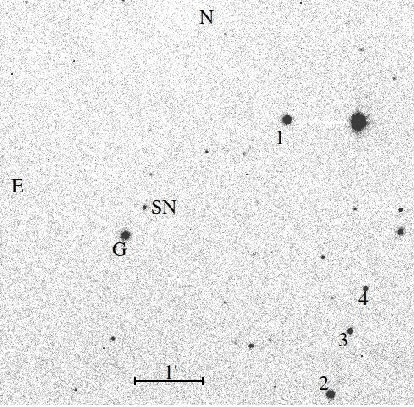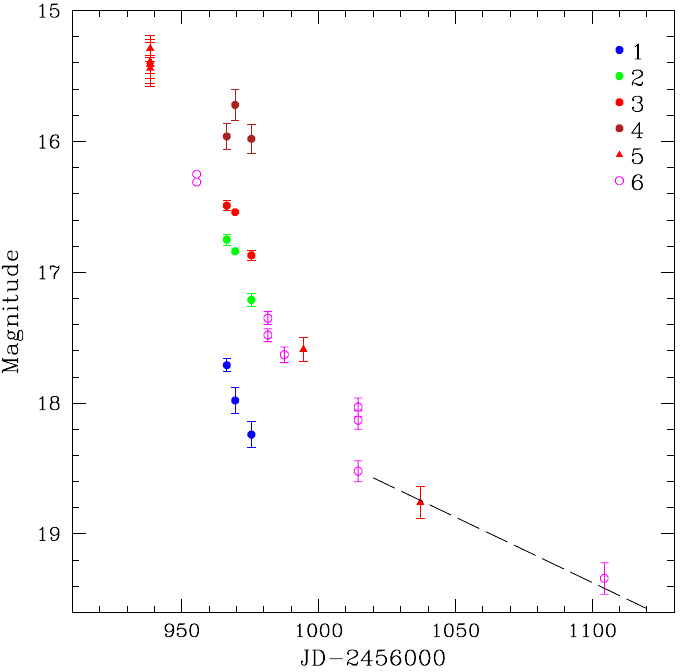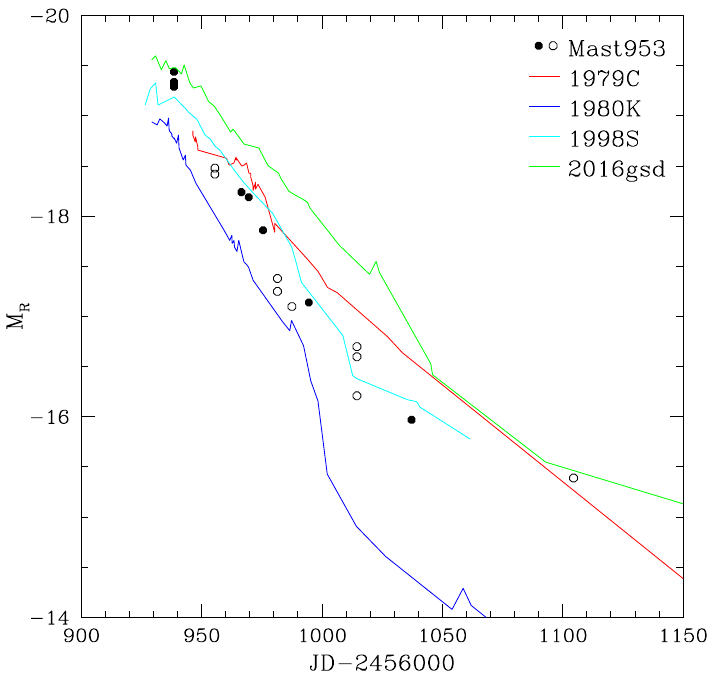|
Peremennye Zvezdy (Variable Stars) 45, No. 7, 2025 Received 24 February; accepted 6 March. |
Article in PDF |
|
DOI: 10.24412/2221-0474-2025-45-77-81
|
MASTER OT J095321.02+202721.2: Luminous Type II-L Supernova
D. Yu. Tsvetkov, V. M. Lipunov, P. V. Balanutsa, A. S. Kuznetsov
M.V.Lomonosov Moscow State University, Sternberg Astronomical Institute, Universitetskii pr.13, 119234 Moscow, Russia
|
The optical transient MASTER OT J095321.02+202721.2,
discovered in 2014, was not classified or confirmed as a
supernova. We present the light curve of this object which allows
us to classify it as a type II-L supernova with the absolute
magnitude at maximum brightness
|
Modern wide-field sky surveys discover many transients, and a
significant part of them remain unclassified. Most of the
unclassified transients are fainter than
![]() , but
sometimes, even much brighter objects remain unexplored. One of
them is MASTER OT J095321.02+202721.2 (an abbreviated designation
Mast953 is used hereafter). It was discovered by the
MASTER-Kislovodsk auto-detection system at
, but
sometimes, even much brighter objects remain unexplored. One of
them is MASTER OT J095321.02+202721.2 (an abbreviated designation
Mast953 is used hereafter). It was discovered by the
MASTER-Kislovodsk auto-detection system at
![]() (J2000), on 2014-10-08.05230 UT, its unfiltered magnitude was
(J2000), on 2014-10-08.05230 UT, its unfiltered magnitude was
![]() . The object was located
. The object was located ![]() West and
West and ![]() North of
the center of the galaxy 2MASX J09532220+2026551 at
North of
the center of the galaxy 2MASX J09532220+2026551 at ![]() (Balanutsa et al. 2014). The transient was also detected by
Catalina Sky Survey (CSS) and designated
CSS 141025:095321+2027211.
(Balanutsa et al. 2014). The transient was also detected by
Catalina Sky Survey (CSS) and designated
CSS 141025:095321+2027211.
Our photometric observations were performed by MASTER telescopes at Kislovodsk and Tunka sites (Lipunov et al. 2010) and at the 60-cm telescope of the Crimean Astronomical Station of Sternberg Astronomical Institute (SAI CAS), Lomonosov Moscow University. The standard image reductions and photometry were made using IRAF2. Photometric measurements of the SN were made relative to local standard stars using PSF fitting with the IRAF DAOPHOT package.
The image of SN Mast953 and comparison stars is shown in Fig. 1. The stars were calibrated using Gaia synthetic photometry3. The SN is located in an area with low surface brightness, and subtraction of galaxy background is not necessary.
The results of photometry are reported in Table 1, and the light
curves are shown in Fig. 2. In the Table, the uncertainties are
presented in parentheses, the telescope codes are: M40, 40-cm
MASTER telescopes; C60, the 60-cm telescope of the SAI CAS.
Unfiltered MASTER images were calibrated with ![]() -band magnitudes
of the comparison stars. We also plot the data retrieved from the
CSS site, they agree quite well with our
-band magnitudes
of the comparison stars. We also plot the data retrieved from the
CSS site, they agree quite well with our ![]() -band magnitudes.
There are no observations on the rising branch of the light curve,
and the maximum cannot be determined reliably.
-band magnitudes.
There are no observations on the rising branch of the light curve,
and the maximum cannot be determined reliably.
| JD |
Tel. | ||||
| 6938.55 | 15.41 (0.07) | M40 | |||
| 6938.55 | 15.44 (0.08) | M40 | |||
| 6938.60 | 15.41 (0.17) | M40 | |||
| 6938.60 | 15.29 (0.10) | M40 | |||
| 6938.60 | 15.39 (0.17) | M40 | |||
| 6966.58 | 17.71 (0.05) | 16.75 (0.04) | 16.49 (0.04) | 16.46 (0.10) | C60 |
| 6969.57 | 17.98 (0.10) | 16.84 (0.03) | 16.54 (0.03) | 16.22 (0.12) | C60 |
| 6975.52 | 18.24 (0.10) | 17.21 (0.05) | 16.87 (0.04) | 16.48 (0.11) | C60 |
| 6994.47 | 17.59 (0.09) | M40 | |||
| 7037.33 | 18.76 (0.12) | M40 |
 |
Fig. 1.
SN Mast953 and comparison stars. G is
the nucleus of the host galaxy. The image was obtained at the
60-cm telescope of SAI CAS with the |
 |
Fig. 2.
The light curve of SN Mast953. 1, 2, 3, 4:
|
The brightness in the ![]() band decreased nearly linearly during
band decreased nearly linearly during
![]() days after discovery, with a rate
days after discovery, with a rate ![]() mag/day.
The decline rate slowed down at about JD2457025, and after this
date, it was about 0.009 mag/day, which is close to the rate
expected from the radioactive decay of
mag/day.
The decline rate slowed down at about JD2457025, and after this
date, it was about 0.009 mag/day, which is close to the rate
expected from the radioactive decay of ![]() Co to
Co to ![]() Fe. The
photometric evolution is typical of SNe II-L.
Fe. The
photometric evolution is typical of SNe II-L.
 |
Fig. 3.
The light curve of SN Mast953 in absolute
|
This is confirmed by comparison of the light curve of SN Mast953
in absolute ![]() -band magnitudes to those for four type II-L SNe:
1979C, 1980K, 1998S and 2016gsd (Balinskaia et al. 1980; Buta
1982; Fassia et al. 2000; Reynolds et al. 2020), which is shown in
Fig. 3. The distance to SN Mast953 was estimated from the galaxy's
redshift, using
-band magnitudes to those for four type II-L SNe:
1979C, 1980K, 1998S and 2016gsd (Balinskaia et al. 1980; Buta
1982; Fassia et al. 2000; Reynolds et al. 2020), which is shown in
Fig. 3. The distance to SN Mast953 was estimated from the galaxy's
redshift, using ![]() km s
km s![]() Mpc
Mpc![]() ; the distance
modulus is
; the distance
modulus is ![]() . We corrected the magnitudes for small
Galactic extinction
. We corrected the magnitudes for small
Galactic extinction
![]() 4. The location of SN Mast953 in the
host galaxy allows us to assume that host extinction is
negligible. The distances and extinctions for the SNe from
comparison sample were taken from the papers cited above.
4. The location of SN Mast953 in the
host galaxy allows us to assume that host extinction is
negligible. The distances and extinctions for the SNe from
comparison sample were taken from the papers cited above.
The absolute magnitude of SN Mast953 at discovery is about
![]() , and it may be even brighter because the
maximum could not be determined reliably. This value is high even
for type II-L SNe, for which the mean absolute magnitude was
estimated by Richardson et al. (2014):
, and it may be even brighter because the
maximum could not be determined reliably. This value is high even
for type II-L SNe, for which the mean absolute magnitude was
estimated by Richardson et al. (2014):
![]() . Type II
SNe have quite blue colors near maximum, for example, for SN 1998S
the color was
. Type II
SNe have quite blue colors near maximum, for example, for SN 1998S
the color was
![]() (Fassia et al. 2000), so the
mean
(Fassia et al. 2000), so the
mean ![]() is close to mean
is close to mean ![]() , and SN Mast953 is at least
about
, and SN Mast953 is at least
about
![]() brighter than an average SN II-L.
brighter than an average SN II-L.
The light curves presented in Fig. 3 are similar in shape and luminosity, SN 1998S appears to be the best match for SN Mast953. We conclude that this comparison permits a definite classification of SN Mast953 as type II-L SN with a very high luminosity at maximum.
Acknowledgements
The study was conducted under the state assignment of Lomonosov Moscow State University.
References:
Balanutsa, P., Denisenko, D., Lipunov, V., et al. 2014, Astronomer's Telegram, No. 6554
Balinskaia, I. S., Bychkov, K. V., & Neizvestnyi, S.I. 1980, Astron. & Astrophys., 85, No. 3, L19
Buta, R.J. 1982, Publ. Astron. Soc. Pacific, 94, 578
Fassia, A., Meikle, W. P. S., Vacca, W. D., et al. 2000, Monthly Notices Roy. Astron. Soc., 318, No. 4, 1093
Lipunov, V., Kornilov, V., Gorbovskoy, E., et al. 2010, Advances in Astronomy, article id. 349171
Reynolds, T. M., Fraser, M., Mattila, S., et al. 2020, Monthly Notices Roy. Astron. Soc., 493, No. 2, 1761
Richardson, D., Jenkins, R. L., Wright, J., Maddox, L. 2014, Astron. J., 147, article id. 118